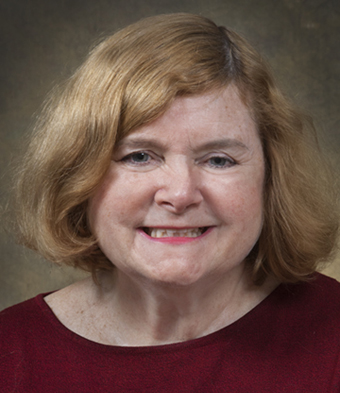Jean Peduzzi-Nelson
Position Title
Associate Professor and Director, Medical NeuroscienceOffice Location
7133 Scott Hall, 540 E. CanfieldOffice Phone
313-577-8995Biography
Early in my career, I focused on nervous system development. Later, I began working with another faculty member who was developing a treatment for chronic, severe spinal cord injury (SCI). My moderate interest in research changed into an obsession to help these people with SCI and brain injury. Most people with SCI have chronic injuries and demonstrate little improvement with rehabilitation. After many years of limited success, I invited a clinician from Portugal who was starting a pilot clinical study using pieces of olfactory mucosa grafted into the cystic cavity of people with chronic, severe SCI. During his visit, we implanted olfactory tissue into rats with chronic, severe SCI. Much to my surprise, these rats improved more than any of rats that I did using other treatments for the previous 6 years so I was convinced that the olfactory mucosa stem cells were a promising treatment. In examining the clinical data, it was obvious that the rehabilitation program was critical to obtain improvement.
In the last 10 years, I have been invited to an international research conference, received WSU and SOM teaching awards, and testified at US Senate committees.
Research
Current Research Projects
Preclinical studies: In collaboration with Dr. Harini Sundaraghavan (Bioengineer) and Dr. Asad Mazhari (Neurosurgeon), we designed and grafted an artificial spinal cord into rats that had a segment of spinal cord removed. Some of these rats regained forelimb-hindlimb coordination and would appear to walking normally to a person unfamiliar with rat locomotion. The artificial spinal cord replicates the normal cytoarchitecture of spinal cord and contains several cell types and bioengineered scaffolding to direct axonal growth.
Clinical Trial: In collaboration with Dr. Meythaler and others, the clinical trial will determine the effects of exercise or exercise & environmental enrichment on cognition and balance in people with traumatic brain injury. There have been 32 rodent studies demonstrating enrichment improves brain function but no clinical studies. Participants receive 2 hours of testing before & after the 8 weeks of exercise classes.
Publications
1. Peduzzi, J.D., T.B. Grayson, F.R. Fischer and E.E. Geisert, Jr. (1999) The expression of TAPA (CD81) correlates with the reactive response of astrocytes in the developing rat CNS. Exp. Neurol. 160:460-468. Medline
2. Bittner, G.D. T. Schallert, and J. D. Peduzzi. (2000) Degeneration, Trophic Interactions and Repair of Severed Axons: A Reconsideration of Some Common Assumptions, The Neuroscientist, 6: 88-110.
3. Meythaler, J.M, J.D. Peduzzi, and T.A. Novack. (2001) Current concepts: diffuse axonal injury associated traumatic brain injury. Archiv. Phys. Med. Rehab., 82:1461-1471. Medline
4. Jackson, C., C. Cobbs, J.D. Peduzzi, M. Novak, C. Morrow. (2001) Repetitive intrathecal injections of Poliovirus Replicons result in gene expression in neurons of the central nervous system without pathogenesis. Hum. Gene Ther. 12: 1827-1842. (cover photo) Medline
5. Woerly, S., V.D. Doan, F. Evans-Martin, C.G. Paramore, and J.D. Peduzzi. (2001) Spinal cord reconstruction using NeurogelTM and functional recovery after chronic injury. J. Neurosci. Research, 66:1187-1197. Medline
6. Morrow, C.D., M.T. Palmer, C. Jackson, L.K. Johansen, A. Bledsoe, D.C. Ansardi, D.C. Porter, C.S. Cobbs, and J.D. Peduzzi. Targeting of poliovirus replicons to neurons in the central nervous system. In Vector Targeting for Therapeutic Gene Delivery D.T. Curiel and J.T. Douglas (eds), Wiley Publishing, 2002.
7. Jackson, C.A., J. Messinger, M.S. Palmer, J.D. Peduzzi, and C. Morrow. (2003) Intramuscular inoculation of encapsidated or naked poliovirus replicons results in gene expression in the muscle and central nervous system. Virology. 314 (1): 45-61. (Cover photo) Medline
8. Jackson CA. Messinger J. Peduzzi JD. Ansardi DC. Morrow CD. (2005) Enhanced functional recovery from spinal cord injury following intrathecal or intramuscular administration of poliovirus replicons encoding IL-10. Virology. 336:173-83. (Cover photo) Medline
9. Lima, C., J. Pratas-Vital, P. Escada, A. Hasse-Ferreira, C. Capucho and J.D. Peduzzi. (2006) Olfactory mucosa autografts in human spinal cord injury a pilot clinical trial. J Spinal Cord Med. 29(3):191-203. Medline
10. Fischer, F.R. and J.D. Peduzzi. (2007). Functional Recovery in Rats with Chronic Spinal Cord Injuries after Exposure to an Enriched Environment. J. Spinal Cord Med. 30(2):147-155.
11. Lujan, H.L., G. Palani, Y. Chen, J.D. Peduzzi, S. E. DiCarlo. (2009) Targeted Ablation of Cardiac Sympathetic Neurons Reduces Resting, Reflex and Exercise-Induced Sympathetic Activation in Conscious Rats. Am J Physiol Heart Circ Physiol 296:H1305-H1311.
12. Hao, H-N., J.D. Peduzzi, P.J. VandeVord, K. Barami, S.P. DeSilva, D. Pedinkovic, L.G. Morawa. (2009) Lipopolysaccharide-induced inflammatory cytokine production by Schwann's cells dependent upon TLR4 expression. J. Neuroimmunology 212: 26-34.
13. Lujan, H.L., G. Palani, Y. Chen, J.D. Peduzzi, S. E. DiCarlo. (2009) Targeted Ablation of Mesenteric Projecting Sympathetic Neurons Reduces the Hemodynamic Response to Pain in Conscious Paraplegic Rats, Submitted American Journal of Physiology - Regulatory, Integrative and Comparative Physiology. 296:1305-1311.
14. Peduzzi, JD, C Lima, EM Haacke, E Dawe, B Semakula, J Jacobs, JP McAllister, K. Casey, J. Meythaler, (2010) MRI and Histochemical Localization of SPIO-Labeled Olfactory Mucosa Progenitor Cells Injected in the Cerebrospinal Fluid of Normal and Injured Rats And Pigs, J.Neurotrauma 27(5):A88.
15. Lima, C., P. Escada, J. Pratas-Vital, C. Branco, C.A. Arcangeli, G. Lazzeri, C.A.S. Maia, C. Capucho, A. Hasse-Ferreira, and J.D. Peduzzi (2010) Olfactory Mucosal Autografts and Rehabilitation for Chronic Traumatic Spinal Cord Injury. Neurorehab & Neural Repair 24:10-22.
